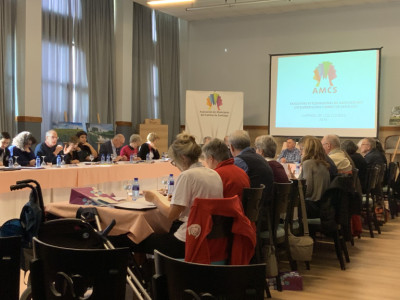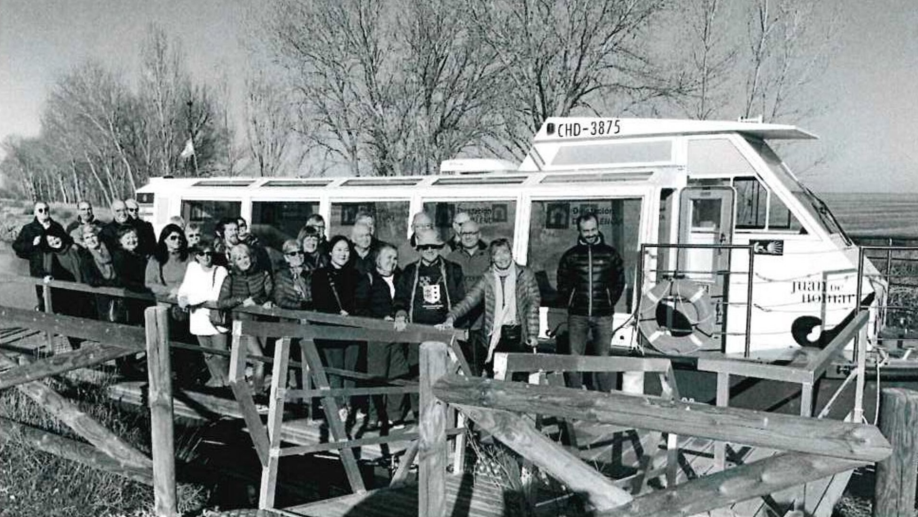
The first International meeting of associations of friends of Saint James Way brought together in Carrión de los Condes different associations of friends of the Camino from around the world. This event was organized by the Asociación de Municipios del Camino de Santiago (AMCS) in collaboration with the Provincial Council of Palencia and Correos. Here, they talked about important issues for the pilgrimage and in preparation for the upcoming Holy Year in 2021.
The topics discussed in the presentations were:
The traditional reception is a distinctive feature of the Camino de Santiago. Altruism and the encounter are a fundamental part of hospitality, which must be encouraged to maintain the values of the Camino de Santiago.
The volunteer hosts or hospitaleros are the central figure of this reception. In order for them to perform their duties as effectively as possible, it is important for them to have been pilgrims before and thus understand the needs of other pilgrims.
Donation and non-profit shelters (albergues de donativo) have become a symbol of the Way that needs to be protected, since they also foster the essence of traditional hospitality. The pilgrim must be made aware of the need to make an economic effort to maintain these accommodations.
The actions to be taken for the protection of the traditional reception are: the previous training of the hospitaleros, to fulfill minimum conditions of services and security in the lodgings and to spread the concept of a donation shelter.
The Compostela, which many mistakenly call Compostelana, has become a claim for pilgrims who decide to walk the Camino de Santiago. This has generated agglomerations in the final stages of the pilgrimage.
Regarding this issue, the different associations concluded that the Camino should not only focus on achieving the Compostela, that there are more difficulties of time than distance in the realization of the Camino and that the requirement of 100 km to achieve this certification can become a problem. Today the number of foreigners who walk a long journey is greater compared to the Spaniards, who opt for the short route.
To achieve this, it is important to pay attention to pilgrims along the entire route, a real-time information system of occupancy of the shelters is proposed, as well as limiting the sealing of credentials to the shelters and to provide more places for pilgrims.
The environment, landscape and nature
The pilgrim who ventures to travel the Camino hopes to find a clean, friendly and welcoming environment. Unfortunately, along the various Jacobean Routes there are acts of destruction of the landscape, nature and environmental damage. Here, the Friends of the Way Associations have a fundamental role in raising the pilgrim's awareness of the importance of caring for the environment.
Some actions to care for the environment on the Camino de Santiago are the cleaning of it by volunteers, pilgrims and neighbors. The Friends of the Way Associations can provide pilgrims with bags for the collection of waste, raise awareness of the importance of respecting the landscape and encourage appreciation for nature through photography competitions. Fruit trees can be planted in pilgrim rest areas, and also encourage to buy fruit from local farmers and provide information on local farming practices, culture and architecture.
Tourism and pilgrimage are two topics that have gone hand in hand for centuries. Religious tourism is beneficial for the local economy, but it should not alter or undermine the values of the Camino, so measures must be taken so that this does not happen.
The Camino today is multicultural and multireligious. Visiting places of worship is one of the pilgrim's interests, so the entrance must be facilitated with flexible schedules and access to a place of meditation.
The arrival of foreign pilgrims creates the need to provide information in different languages. This can be solved by facilitating printed or written multilingual information or with trained volunteer personnel.
It is also proposed to publicize, expand and execute the “Un paso limpio” project to keep the Camino clean, the possibility of placing signs in fountains indicating if the water is safe to drink or not, the distance to the next water source, and promoting the use of flasks instead of plastic bottles.
Other actions were to establish special prices for pilgrims in restoration and places of tourist interest and to give priority in public shelters to pilgrims that travel alone, couples or in small groups. It should be possible to have enough shelters in the off-season to accommodate pilgrims. For security it is important to give information prior to the arrival of the pilgrim to the Camino, control the pilgrim's registry and establish lockers and surveillance cameras for luggage.
The French Way is the most important pilgrimage itinerary to Santiago de Compostela. Along this and other paths, elements such as heritage, spirituality and research enter a symbiosis. In addition to fully defending the Way, its cultural and intangible heritage must be taken into account, since the Camino is not only a route, but also its cults, stories, legends and traditions.
To maintain and defend this, some actions where proposed in these debates such as the development of an app to inform about the heritage of the Way, provide pilgrims with information about the local culture and attend to the heritage also on alternative routes to the Camino.
Waymarking is a very important part of the pilgrimage, as it guides the pilgrim along the Way and gives security to foreign pilgrim that don’t speak the local language.
To improve signaling, the Association of Municipalities of the Camino de Santiago (AMCS) proposes to apply its Signaling Manual and implement it in urban environments of the Camino. In addition, it was proposed to place QR codes in the Road signage with information in several languages and continue supporting waymarking projects for dissemination and implementation.

This meeting was closed with the completion of a stage of the Camino de Santiago in Palencia and guided visits to monuments of Boadilla del Camino, Frómista, Villacázar de Sirga and Carrión de los Condes. There was also a boat trip along the Canal de Castilla.
Your email address will not be published.
Mandatory fields are marked with *



